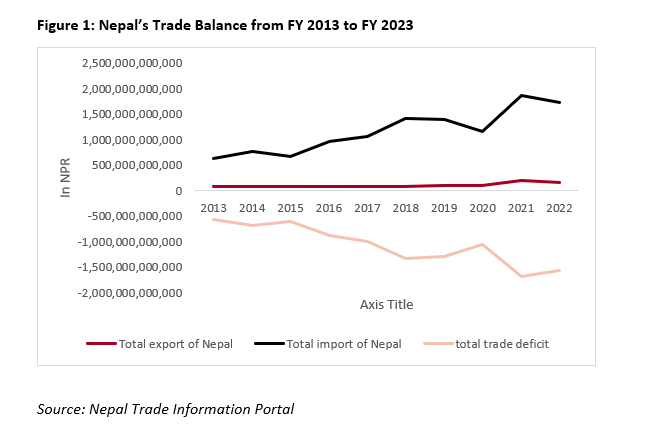The trade deficit of the country already reached NPR 366.88 billion (USD 2.76 billion) during the initial three months of the FY 2023/24, spanning from mid-July to mid-October.
Nepal grappled with a substantial trade deficit of NPR 1.454 trillion (USD 11.04 billion), with exports amounting to NPR 157.140 billion (USD 1.19 billion) in comparison to NPR 1.611 trillion (USD 12.25 billion) in imports during FY 2022/23. After analysing the trend of Nepal’s trade deficit, it is clear that the trade deficit has consistently remained negative over the course of many years. This consistent negative trade balance implies the ongoing challenge of trade imbalance the country faces. Trade imbalance significantly impacts the economy, leading to consequences such as unemployment, inflation, economic instability, and a direct impact on the livelihoods of its citizens. For instance, Nepal’s heavy reliance on India for importing goods and services became evident during the blockade in 2015, resulting in significant hardships for the country and its citizens.
The trade deficit of the country already reached NPR 366.88 billion (USD 2.76 billion) during the initial three months of the FY 2023/24, spanning from mid-July to mid-October. During the initial three months of the current FY 2023/24, the trade deficit experienced a slight uptick, primarily due to a 1.6% increase in imports. This underscores Nepal’s heavy reliance on imports. Moreover, the trade deficit expanded by approximately NPR 7.70 billion (USD57.99 million) when compared to the corresponding period of the previous FY 2022/23. As per the Nepal Trade Statistics released by the Department of Customs (DoC), the nation’s overall trade deficit increased by 2.15% compared to the figure of NPR 359.18 billion recorded during the corresponding period of the previous FY 2022/23.
Challenges
Numerous factors contribute to Nepal’s trade deficit. Some potential challenges include:
Geographical structure and landlockedness
When it comes to international trade, landlocked nations face a number of challenges, both in terms of exporting and importing goods via neighbouring countries’ routes. High shipping and transportation costs, as well as the risk of spoilage or damage to perishable goods, are among the challenges. Nepal has a unique trade pattern because it is surrounded on three sides by India, and the formidable Himalayan mountain range forms its northern border, limiting road access to China. External political disruptions, such as trade blockades at the Indo-Nepal border, have had a direct impact on foreign trade and contributed to the trade deficit.
High cost of Production
Nepal’s trade deficit stems from high sourcing costs, including shipping, customs, and production expenses due to limited resources and skilled labor. The country’s small market size hinders economies of scale, making domestic production costlier than imports, exacerbating the deficit. Quality issues, like pesticide misuse and ingredient mixing, affect consumer willingness to buy, impacting the trade balance. Nepal’s resource shortages and reliance on foreign trade for goods create an imbalance in the domestic economy, hindering growth.
Political instability
Nepal has grappled with political instability since the restoration of democracy in 2047 BS, significantly impacting its economic development. Political instability may lead to short-term policymaking, increasing policy changes and macroeconomic volatility. It disrupts trade by affecting income, prices, and investment, impacting Nepal’s import-export variables and local market competitiveness. Additionally, a decade-long Maoist armed conflict, series of strikes, and events like the 2002-2005 royal coup, Terai strikes, India’s strike in 2012, and the COVID-19 pandemic have had substantial effects on both foreign and domestic trade.
Remittance and devaluation of currency
Currency devaluation has a negative impact on the trade balance. Research indicates that in India, devaluation led to reductions in both exports and imports, while its effect in the rest of the world was found to be insignificant. Devaluing foreign exchange alone may not rectify the trade deficit; instead, strategies like boosting exports through local resource utilization, export subsidies, and curbing imports via fiscal measures and the establishment of import substitution industries may be more effective. As remittances increase disposable income, purchasing power grows, leading to higher demand for consumer goods and other items, ultimately driving up imports.
Outlook
According to The World Bank report, Nepal Development Update 2023, the economy is predicted to rebound, with a growth rate of 3.9% in FY 2023/24 and 5% in FY 2024/25, driven by the removal of import restrictions and monetary policy adjustments. This growth is expected to benefit the wholesale and retail trade and boost the service sector. Increased remittances from Nepali workers abroad will contribute to revenue growth, but it may not completely offset the trade deficit in goods and services. However, the government should recognize the inherent potential and take proactive measures to manage or mitigate trade deficits. To address the trade deficit, exporters should be provided with financial incentives such as tax exemptions and subsidies, while creating new markets to foster competition and encouraging the growth of sectors like manufacturing. Additionally, the government could consider implementing tariffs on imported products. Nepal’s bureaucratic processes hinder business operations, necessitating government reforms and improved education for competitiveness in international markets. Government-funded training programs are necessary. Nepal can enhance its international business environment by reducing red tape, improving infrastructure, and offering tax incentives. It can also lower imports and grow export-oriented sectors, while devaluing the rupee could increase import costs and export competitiveness.
Pratisha Lakhey is an undergraduate student in Economics from Kathmandu University School of Arts. Her interest lies in development economics, public policy and microeconomics. She is currently working as an intern at NEF.

